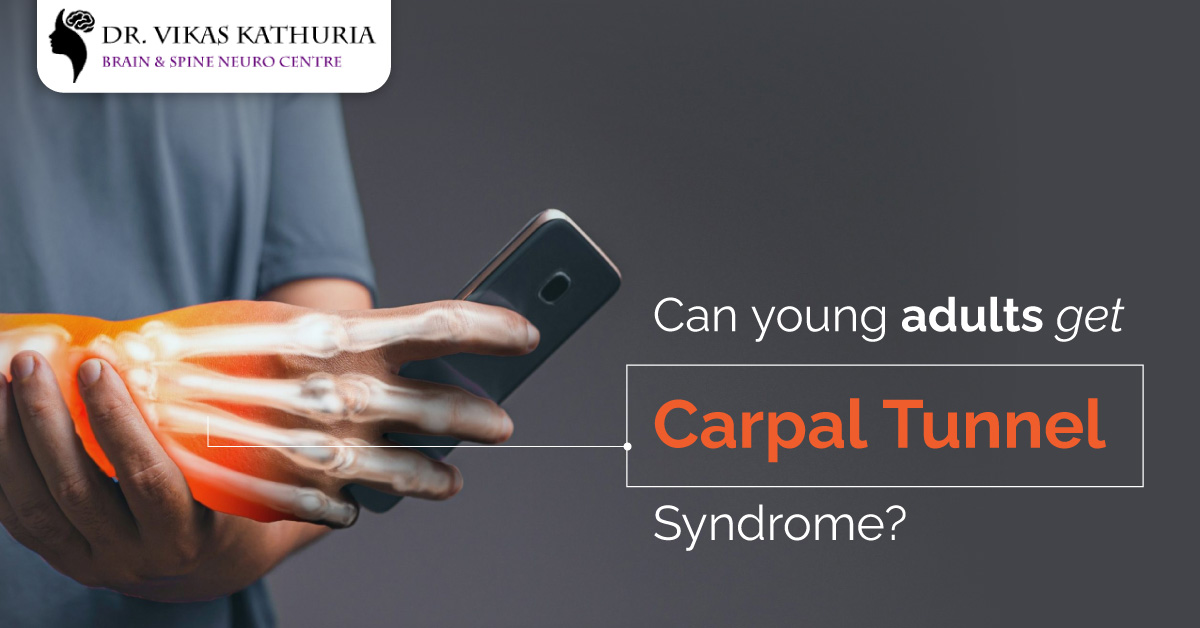Can young adults get Carpal Tunnel Syndrome

You might have carpal tunnel syndrome if your fingers hurt and feel tingly, especially in the middle of the night or when you wake up. As you squeeze the median nerve in the wrist, it leads to carpal tunnel. At the bend of the wrist, this nerve goes through a tunnel, but in some people, the tunnel is too small. This makes patients feel tingling, numbness, and sometimes burning pain. At this time you should contact the best neurosurgeon in Gurgaon.
Most people can deal with the symptoms, at least at first. But as the condition worsens and the nerve continues to be pressed on, the symptoms worsen and can eventually be there all the time. This can make things complicated when:
- Holding a book to read 
- Holding the steering wheel to drive 
- Using a smartphone
People in their 20s to 30s can suffer from carpal tunnel, but it usually gets worse when people are in their 40s or 50s. The typical patient is someone who works at a desk all day and types on a keyboard. But people with different jobs can get carpal tunnel, especially dental hygienists and construction workers who use vibrating tools every day and people whose jobs require them to move their wrists forcefully and repeatedly. Most people who get carpal tunnel have no apparent causes.
Most carpal tunnel symptoms can be treated without surgery or with surgery, especially if the condition is caught early. To get the best results and avoid problems that could last for a long time, you should see a doctor who specializes in treating hand and wrist problems.
Why does carpal tunnel happen?
Carpal tunnel syndrome occurs when the space in the wrist gets smaller. This puts pressure on the median nerve and tendons in the carpal tunnel. This makes the nerve and tendons swell, which stops the fingers and hand from feeling.
How often does carpal tunnel cause pain in the hands?
Carpal tunnel syndrome is a common condition, but its symptoms differ from many other hand pain causes. Several similar things can hurt your hands. These things are:
- De Quervain’s tendinosis is a condition in which the wrist and the base of the thumb swell up because of inflammation. When you have this condition, making a fist and shaking someone’s hand will hurt.
- Trigger finger: This is a painful condition that hurts the base of the finger or thumb. When you bend your fingers and thumb, the trigger finger can cause pain, locking (or catching), and stiffness.
- Arthritis: This is an umbrella term for many conditions that make your joints stiff and swollen. Arthritis can affect many joints and can range from making you feel a little pain to destroying the joint over time (osteoarthritis is one type of degenerative arthritis).
What do people with carpal tunnel syndrome feel like?
Usually, symptoms come on slowly and can happen at any time. Some early signs are numbness at night.
- Pain or tingling in the fingers, especially the index, thumb, and middle fingers.
Nighttime symptoms are common and can wake people up because some people sleep with their curled wrists. Most of the time, these nighttime symptoms are the first ones people notice. In the early stages of the disease, shaking hands helps ease the symptoms.
Some daytime symptoms include 
- fingers that feel tingly.
- Less feeling in the tips of the fingers.
- Difficulty doing small tasks with the hand, 
As carpal tunnel syndrome gets worse, you will feel the below-mentioned symptoms:
- Weakness in the hand is one of these signs.
- Not being able to do things that require small movements (such as buttoning a shirt).
- Putting things down.
In the worst case, the muscles at the base of the thumb can be seen to get smaller (atrophy).
How do you treat carpal tunnel syndrome?
There are two ways of Carpal Tunnel Syndrome Treatment: without surgery or with surgery. Both methods have good points and bad points. Most of the time, non-surgical treatments are used for less severe cases. In more severe cases, surgery can help, and the results are usually excellent.
Treatments without surgery
Most of the time, non-surgical treatments are tried first. The first step of treatment is to wear a wrist splint at night.
- Taking nonsteroidal pain relievers like ibuprofen.
- Injections of cortisone.
Other treatments try to change your environment to make your symptoms go away. This often happens at work, where you can make changes to help prevent carpal tunnel. Some of these changes could be: Putting your chair higher or lower.
- Moving the keyboard on your computer.
- Changing the position of your hand or wrist while doing things.
- Doing the exercises and heat treatments that a hand therapist suggests.
Surgical treatments
Surgery is often the best option when non-surgical treatments don’t work or carpal tunnel syndrome is already wrong. Surgery aims to make the tunnel bigger so that the nerves and tendons that go through it don’t have to work as hard. To do this, the ligament that covers the carpal tunnel at the base of the palm is cut or released. The transverse carpal ligament is the name for this band of tissue.
If you think you are going through carpal tunnel syndrome, you should see a doctor like Dr. Vikas Kathuria as soon as possible. The longer you wait, the more the nerve will change in a way that won’t go away, even with surgery.
